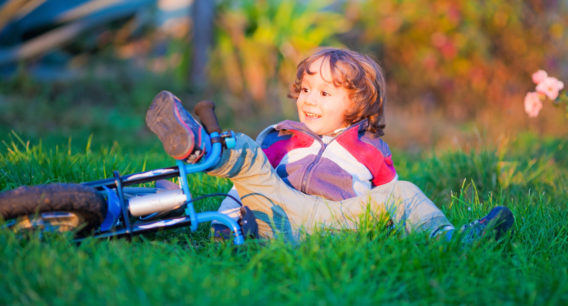
Here is our step by step guide to teaching your child to ride a bike.
The first skill your child needs to master is to balance on two weeks. This is why a balance bike is best to start with, not a bike with stabilisers or training wheels as pedalling comes much later.
Balance bikes are low to the ground, have no pedals and usually no brakes. They are designed for a small child to push and glide on a flat surface.
If you cannot afford a balance bike, buy a normal child’s bike with a freewheel (so they can cruise without pedalling) and remove the pedals of the bike for the first stage of learning. We wouldn’t recommend teaching a child to ride on a bike with fixed wheels.
Encourage your child to sit on the balance bike and roll very slowly down the incline or slope, putting down one foot and the other.
It is easier to do this if the bike gains a little speed. If the bike can roll without her help, she can try to lift her feet off the ground for longer and longer periods.
Repeat this at least 20 times until she can cruise with her feet off the ground the whole way.
It is easier for her to do this without you holding her. If you do hold her it’s better to hold her shoulders. Don’t hold the handlebars as you will make them wobble.
When your child is able to balance on this slope take her on longer rides on the flat where she can practice pushing with her feet and cruising.
When your child has mastered balancing get her to balance and turn, both right and left.
Repeat this 20 times for each turn.
Then get your child to cruise in big clockwise and counter-clockwise (anti-clockwise) directions.
These 4 steps shouldn’t be rushed and might take weeks or months or years! It’s fine!
Now move to a pedal bike (or put the pedals back on).
Return to the grassy gentle slope as pedalling is much easier if gravity helps speed up the bike.
Teach your child to get the pedal of her non-resting foot ready at the top of its revolution so that when she lifts her foot the pedal is in the right position.
Do this with the aim of getting the other foot onto the pedal and cruising down the slope (without pedalling) for a few moments.
Repeat 20 times.
Next encourage your child to get her other foot onto the other pedal for a few seconds as she cruises down the slope.
Repeat 20 times until she can cruise with both feet on the pedals but not pedalling.
Your child may automatically pedal, if so that’s great. If not you need to encourage her to pedal gently down the slope. For safety reasons there should be a big space at the bottom of the hill so she can slow down and stop.
Once she can rest her feet on the pedals and gently pedal the bike down the slope, she needs to learn to pedal on the flat.
Get the pedal of the pushing foot ready while the bike is on the flat and get your child to practice pushing hard on the pedal and balancing. Once your child can balance after an initial pedal, get her to bring the other foot onto its pedal for a few seconds.
Once she has mastered the balancing you need to encourage her to extend the amount of time and number of pedals they can do.
When she is comfortable pedalling in a straight line, it’s time to do corners again. A big empty tennis court or empty car park can be a good place to practice pedalling clockwise and counter clockwise. Once she has mastered that, set up some markers so she can do figure of eight circuits.
Once she has complete control of her bike, she can have a go on a quiet road with you so that she learns to ride behind you. In the UK your child can take a Bikeability course to gain the necessary road safety and highway code knowledge to take her first bike ride on a public highway. At first she will need you leading her to be in charge of all highway safety and decisions about when to stop, turn etc.
It is really lovely when you and your child can go on a bike ride together. It’s much nicer to avoid road traffic at first so your child can enjoy the feeling of riding a bike and looking where she is going without worrying about road traffic. There are special bicycle routes and paths all around the world to try. Look for local information about bike rides and locations that are suitable for novice riders and small children.